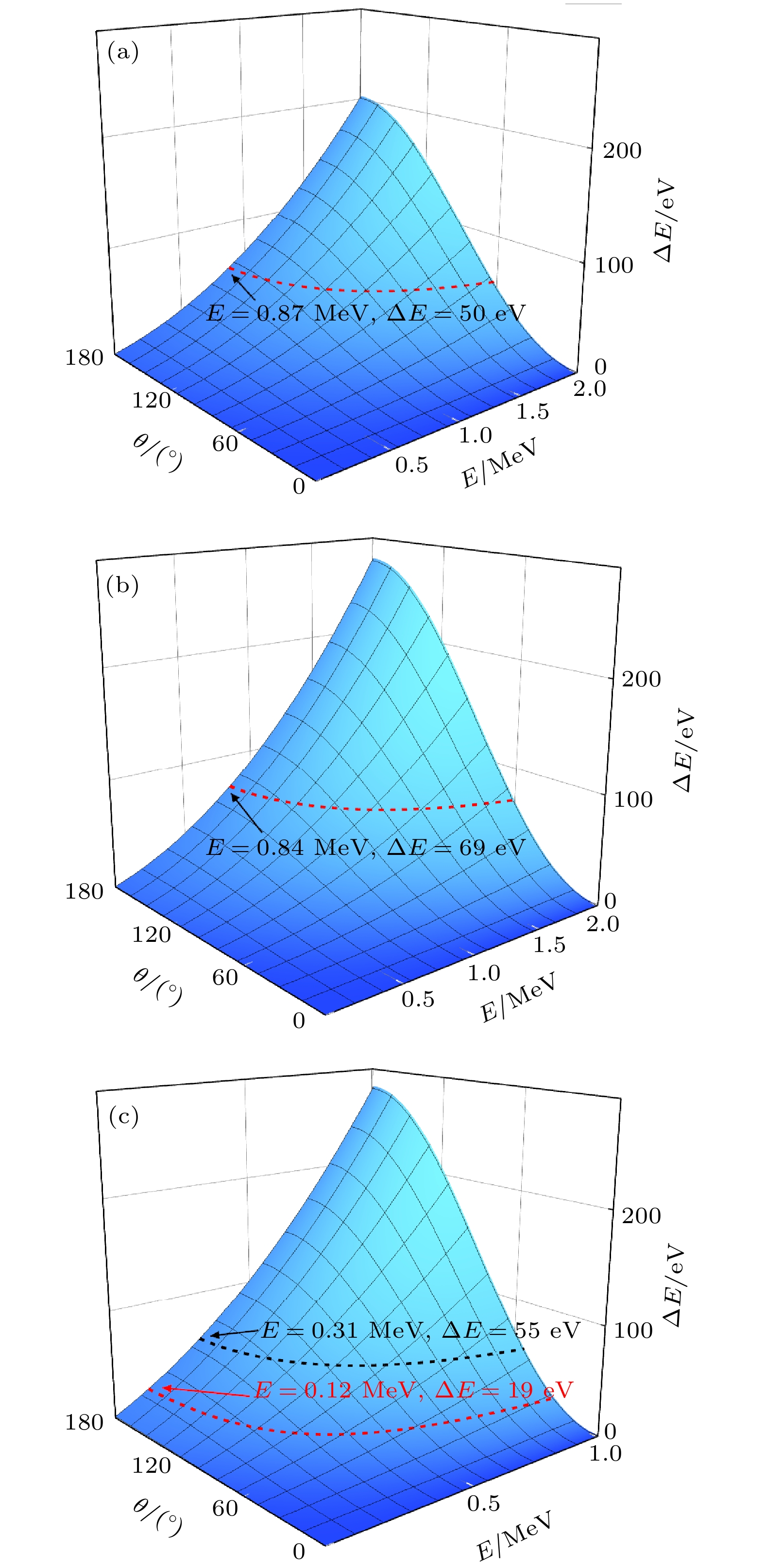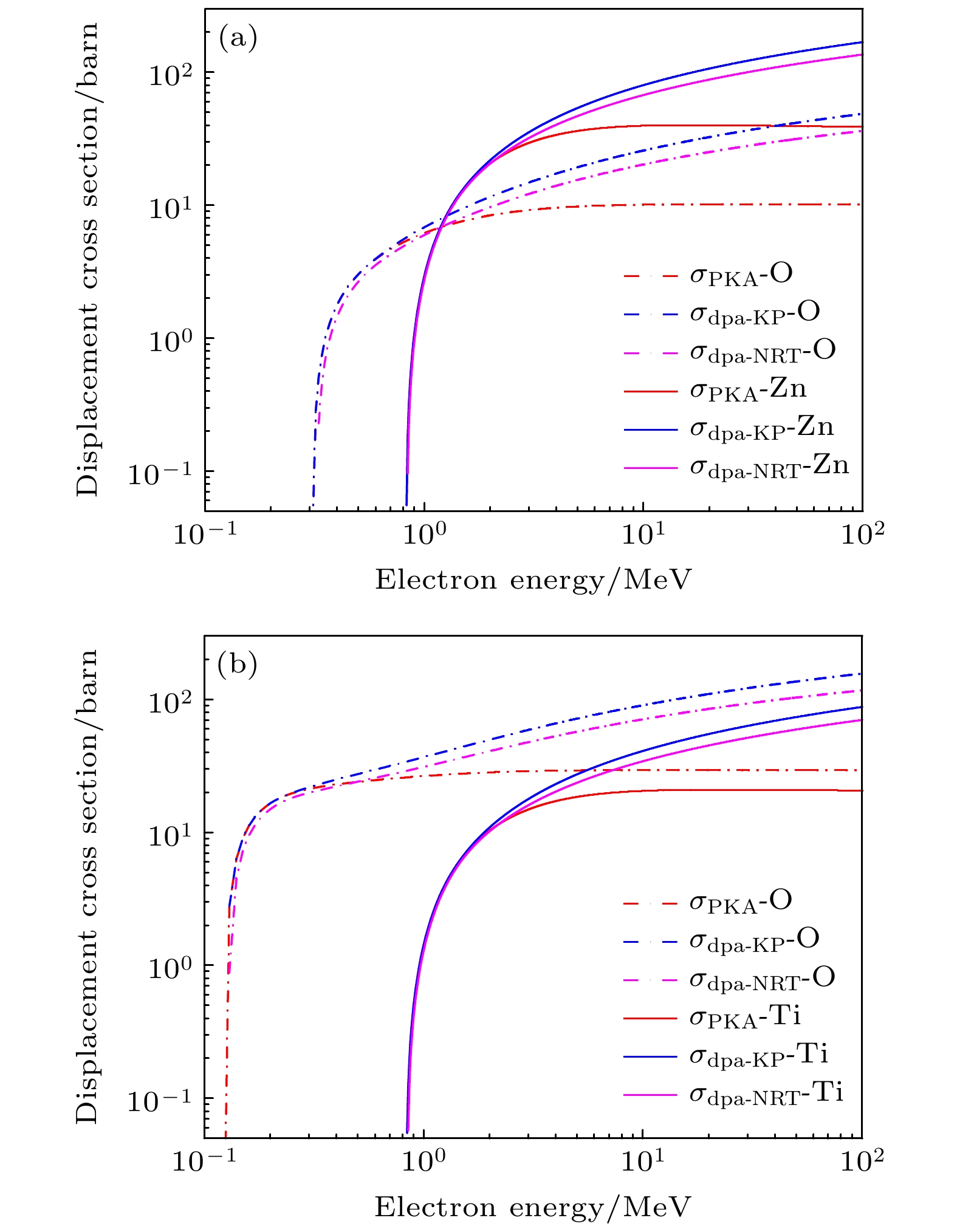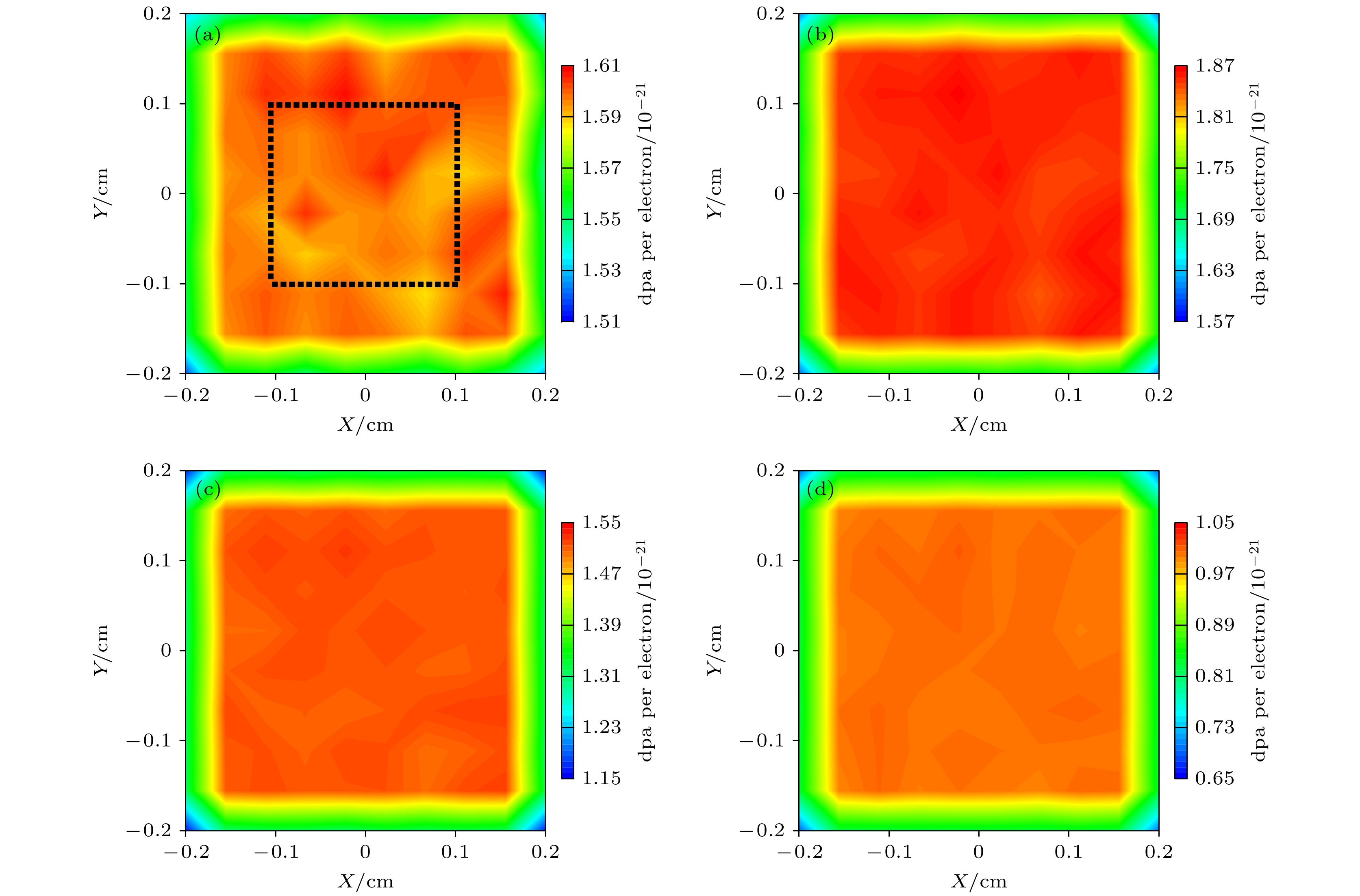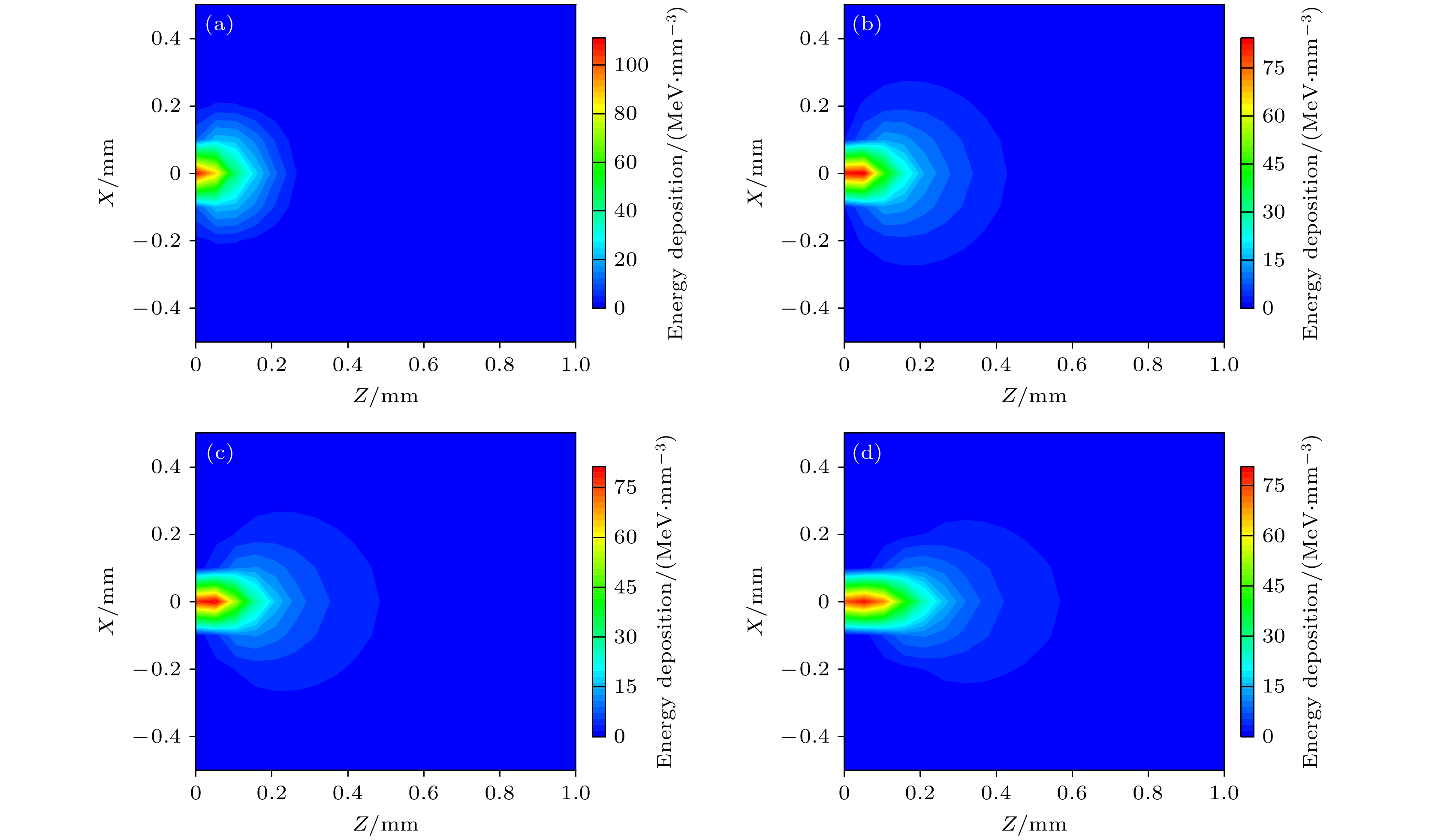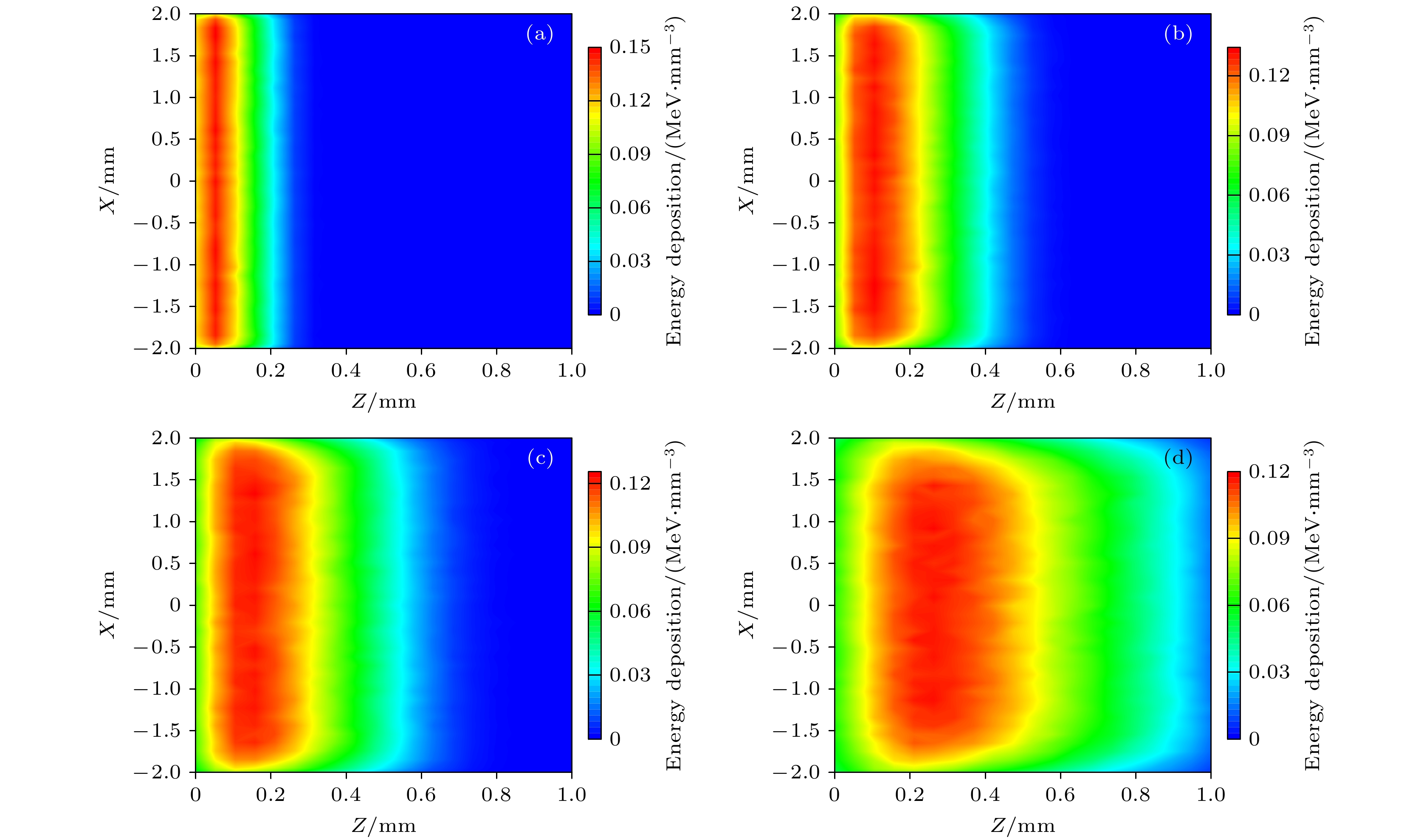-
电子辐照在材料中产生的缺陷主要是相互独立的空位-间隙原子对, 由于不同靶原子的离位阈能不同, 通过改变电子束的能量可以调控在材料中产生的缺陷类型, 同时, 电子的注量又可以决定电子辐照产生的缺陷的浓度. ZnO和TiO2的磁光电特性受Zn空位、Ti空位、O空位、Zn间隙原子、Ti间隙原子等缺陷的影响, 因此可以通过电子辐照的方法在ZnO和TiO2中产生不同浓度的各类缺陷进而研究缺陷对材料磁光电特性的影响. 本文利用MCNP5程序结合蒙特卡罗辅助经典(MCCM)算法模拟计算了不同能量的点源电子束及面源电子束在纤锌矿ZnO和金红石TiO2中产生的辐照损伤(dpa)的大小及分布. 计算结果表明, 点源电子束在样品内部产生的dpa随着入射深度的增加先增大后减小, 而在横向方向很快衰减; 面源电子束产生的辐照损伤在样品内部随着入射深度的增加同样呈现先增加后减小的趋势, 同时dpa的最大值与电子束能量呈二次函数的关系; 电子束能量沉积的计算结果表明, 能量沉积区域的大小与电子束能量密切相关, 同时随着电子束能量的增加, 能量沉积最大值出现的位置逐渐向样品内部移动, 整个能量沉积区域具有前倾的趋势.
-
关键词:
- 电子辐照 /
- 蒙特卡罗辅助经典算法 /
- ZnO /
- TiO2
Wurtzite ZnO and rutile TiO2 have important application value in solar cells, photocatalysts, self-cleaning coatings, etc. In addition, ZnO and TiO2 are crucial basic materials for the development of semiconductor spintronics devices due to room temperature ferromagnetism in the state of defects or doped specific elements. Many studies indicate that the magnetic, optical, and electrical properties of ZnO and TiO2 are affected by intrinsic defects (such as vacancies, interstitial atoms, etc.). Electron irradiation has the incomparable advantages over other particle beam irradiation, the defects produced by electron beam irradiation are mainly independent vacancy-interstitial atom pairs (Frenkel pairs), and there are no new doping elements introduced into the material during the irradiation by electron beam with energy of several MeV, that is, electron irradiation is a relatively “pure” particle irradiation method. On the one hand, since the displacement threshold energy values of different atoms are different from each other, the type of defect during electron irradiation can be controlled by the energy of the electron beam. On the other hand, the electron fluence can determine the concentration of defects. Therefore, various defects of different concentrations can be generated by electron irradiation, thereby studying the influences of related defects on the magnetic, optical, and electrical properties of ZnO and TiO2. However, simulation calculations related to electron beam irradiation damage are relatively scarce. Therefore, in this work, the electron beam irradiation damage is taken as a research topic and the related theoretical simulation calculations are carried out, which lays a theoretical foundation for subsequent experimental researches. The size and the distribution of radiation damage (dpa) caused by point source electrons and that by plane source electrons with different energy values in ZnO and TiO2 are simulated and calculated through the MCNP5 program combined with the MCCM algorithm. The calculation results show that O atoms and Zn atoms can be dislocated when the electron energy values are greater than 0.31 MeV and 0.87 MeV in ZnO, respectively; while in TiO2, O atoms and Ti atoms can be dislocated when the electron beam energy values are greater than 0.12 MeV and 0.84 MeV, respectively. The dpa caused by point source electrons is mainly distributed in the longitudinal direction, and attenuates quickly in the lateral direction; on the contrary, the dpa caused by plane source electrons first increases and then decreases with the augment of the electron incidence depth, and the unevenness of the dpa distribution becomes more serious with the increase of the electron energy. Therefore, for each of ZnO and TiO2, the dpa will be relatively even distribution when the thickness of the sample is about 0.25 mm. Furthermore, the calculation results of the electron energy deposition show that the size of the energy deposition area is closely related to the electron beam energy. At the same time, with the increase of the electron beam energy, the position where the maximum energy deposition appears gradually moves to the inside of the sample, and the entire energy deposition area has a tendency to lean forward.-
Keywords:
- electron irradiation /
- Monte Carlo assited classsical method algorithm /
- ZnO /
- TiO2
[1] Wolf S A, Awschalom D D, Buhrman R A, Daughton J M, von Molnár S, Roukes M L, Chtchelkanova A Y, Treger D M 2001 Science 294 1488
 Google Scholar
Google Scholar
[2] Furdyna J K 1988 J. Appl. Phys. 64 R29
 Google Scholar
Google Scholar
[3] Matsumoto Y, Takahashi R, Murakami M, Koida T, Fan X J, Hasegawa T, Fukumura T, Kawasaki M, Koshihara S Y, Koinuma H 2001 Jpn. J. Appl. Phys. 40 L1204
 Google Scholar
Google Scholar
[4] Xing G Z, Lu Y H, Tian Y F, Yi J B, Lim C C, Li Y F, Li G P, Wang D D, Yao B, Ding J, Feng Y P, Wu T 2011 AIP Advances 1 022152
 Google Scholar
Google Scholar
[5] Zhou S Q, Čižmár E, Potzger K, Krause M, Talut G, Helm M, Fassbender J, Zvyagin S A, Wosnitza J, Schmidt H 2009 Phys. Rev. B 79 113201
 Google Scholar
Google Scholar
[6] Duhalde S, Vignolo M F, Golmar F, Chiliotte C, Torres C E R, Errico L A, Cabrera A F, Rentería M, Sánchez F H, Weissmann M 2005 Phys. Rev. B 72 161313
 Google Scholar
Google Scholar
[7] Olayinka A S, Adetunji B I, Idiodi J O A, Aghemelon U 2019 Int. J. Mod. Phys. B 33 1950036
 Google Scholar
Google Scholar
[8] Kernazhitsky L, Shymanovska V, Gavrilko T, Naumov V, Fedorenko L, Kshnyakin V, Baran J 2014 J. Lumin. 146 199
 Google Scholar
Google Scholar
[9] Liu B J, Liu K, Zhao J W, Wang W H, Ralchenko V, Geng F J, Yang L, Zhang S, Xue J J, Han J C 2020 Diamond Relat. Mater. 109 108026
 Google Scholar
Google Scholar
[10] Fujishima A, Zhang X T 2006 C. R. Chim. 9 750
 Google Scholar
Google Scholar
[11] Lin Q L, Xu N N, Li G P, Qian Z F, Liu H, Wang R H 2021 J. Mater. Chem. C 9 2858
 Google Scholar
Google Scholar
[12] Liu H, Li G P, E D J, Xu N N, Lin Q L, Gao X D, Lan C, Chen J S, Wang C L, Zhan X W, Zhang K 2020 RSC Adv. 10 18687
 Google Scholar
Google Scholar
[13] Liu H, Li G P, E D J, Xu N N, Lin Q L, Gao X D, Wang C L 2020 Opt. Mater. 101 109748
 Google Scholar
Google Scholar
[14] Liu H, Li G P, E D J, Xu N N, Lin Q L, Gao X D, Wang C L 2020 J. Supercond. Nov. Magn. 33 1535
 Google Scholar
Google Scholar
[15] 张梅玲, 陈玉红, 张材荣, 李公平 2019 物理学报 68 087101
 Google Scholar
Google Scholar
Zhang M L, Chen Y H, Zhang C R, Li G P 2019 Acta Phys. Sin. 68 087101
 Google Scholar
Google Scholar
[16] 林俏露, 李公平, 许楠楠, 刘欢, 王苍龙 2017 物理学报 66 037101
 Google Scholar
Google Scholar
Lin Q L, Li G P, Xu N N, Liu H, Wang C L 2017 Acta Phys. Sin. 66 037101
 Google Scholar
Google Scholar
[17] 刘欢, 李公平, 许楠楠, 林俏露, 杨磊, 王苍龙 2016 物理学报 65 206102
 Google Scholar
Google Scholar
Liu H, Li G P, Xu N N, Lin Q L, Yang L, Wang C L 2016 Acta Phys. Sin. 65 206102
 Google Scholar
Google Scholar
[18] 李天晶, 李公平, 马公俊平, 高行新 2011 物理学报 60 116102
 Google Scholar
Google Scholar
Li T J, Li G P, Ma J P, Gao X X 2011 Acta Phys. Sin. 60 116102
 Google Scholar
Google Scholar
[19] Xu N N, Li G P, Pan X D, Wang Y B, Chen J S, Bao L M 2014 Chin. Phys. B 23 106101
 Google Scholar
Google Scholar
[20] Piñera I, Cruz C M, Van Espen P, Abreu Y, Leyva A 2012 Nucl. Instrum. Methods Phys. Res. , Sec. B 274 191
 Google Scholar
Google Scholar
[21] Cruz C M, Piñera I, Correa C, Abreu Y, Leyva A 2011 IEEE Nuclear Science Symposium Conference Record Valencia, Spain, 2011 p4622
[22] Nordlund K, Zinkle S J, Sand A E, Granberg F, Averback R S, Stoller R, Suzudo T, Malerba L, Banhart F, Weber W J 2018 Nat. Commun. 9 1
 Google Scholar
Google Scholar
[23] Edmondson P D, Weber W J, Namavar F, Zhang Y W 2012 J. Nucl. Mater. 422 86
 Google Scholar
Google Scholar
[24] Piñera I, Cruz C M, Abreu Y, Leyva A 2007 Phys. Status Solidi A 204 2279
 Google Scholar
Google Scholar
[25] Pinera I, Abreu Y, Van Espen P, Díaz A, Leyva A, Cruz C M 2011 IEEE Nuclear Science Symposium Conference Record Valencia, Spain, 2011 p1609
[26] Oen O S, Holmes D K 1959 J. Appl. Phys. 30 1289
 Google Scholar
Google Scholar
[27] Cahn J H 1959 J. Appl. Phys. 30 1310
 Google Scholar
Google Scholar
[28] Bethe H A, Ashkin J 1953 Experimental Nuclear Physics (Vol. 1) (London: John Wiley & Sons, Iinc., New York Champan & Hall, Limited) pp252-256
[29] Norgett M J, Robinson M T, Torrens I M 1975 Nucl. Eng. Des. 33 50
 Google Scholar
Google Scholar
[30] Nordlund K, Zinkle S J, Sand A E, Granberg F, Averback R S, Stoller R E, Suzudo T, Malerba L, Banhart F, Weber W J 2018 J. Nucl. Mater. 512 450
 Google Scholar
Google Scholar
[31] Kinchin G H, Pease R S 1955 J. Nucl. Energy (1954) 1 200
 Google Scholar
Google Scholar
[32] McKinley W A, Feshbach H 1948 Phys. Rev. 74 1759
 Google Scholar
Google Scholar
[33] Meese J M, Locker D R 1972 Solid State Commun. 11 1547
 Google Scholar
Google Scholar
[34] Zinkle S J, Kinoshita C 1997 J. Nucl. Mater. 251 200
 Google Scholar
Google Scholar
[35] Smith K L, Colella M 2003 J. Nucl. Mater. 321 19
 Google Scholar
Google Scholar
[36] Robinson M, Marks N A, Whittle K R, Lumpkin G R 2012 Phys. Rev. B 85 104105
 Google Scholar
Google Scholar
[37] Piñera I, Cruz C M, Leyva A, Abreu Y, Cabal A E, Van Espen P, Van Remortel N 2014 Nucl. Instrum. Methods Phys. Res. , Sec. B 339 1
 Google Scholar
Google Scholar
-
-
[1] Wolf S A, Awschalom D D, Buhrman R A, Daughton J M, von Molnár S, Roukes M L, Chtchelkanova A Y, Treger D M 2001 Science 294 1488
 Google Scholar
Google Scholar
[2] Furdyna J K 1988 J. Appl. Phys. 64 R29
 Google Scholar
Google Scholar
[3] Matsumoto Y, Takahashi R, Murakami M, Koida T, Fan X J, Hasegawa T, Fukumura T, Kawasaki M, Koshihara S Y, Koinuma H 2001 Jpn. J. Appl. Phys. 40 L1204
 Google Scholar
Google Scholar
[4] Xing G Z, Lu Y H, Tian Y F, Yi J B, Lim C C, Li Y F, Li G P, Wang D D, Yao B, Ding J, Feng Y P, Wu T 2011 AIP Advances 1 022152
 Google Scholar
Google Scholar
[5] Zhou S Q, Čižmár E, Potzger K, Krause M, Talut G, Helm M, Fassbender J, Zvyagin S A, Wosnitza J, Schmidt H 2009 Phys. Rev. B 79 113201
 Google Scholar
Google Scholar
[6] Duhalde S, Vignolo M F, Golmar F, Chiliotte C, Torres C E R, Errico L A, Cabrera A F, Rentería M, Sánchez F H, Weissmann M 2005 Phys. Rev. B 72 161313
 Google Scholar
Google Scholar
[7] Olayinka A S, Adetunji B I, Idiodi J O A, Aghemelon U 2019 Int. J. Mod. Phys. B 33 1950036
 Google Scholar
Google Scholar
[8] Kernazhitsky L, Shymanovska V, Gavrilko T, Naumov V, Fedorenko L, Kshnyakin V, Baran J 2014 J. Lumin. 146 199
 Google Scholar
Google Scholar
[9] Liu B J, Liu K, Zhao J W, Wang W H, Ralchenko V, Geng F J, Yang L, Zhang S, Xue J J, Han J C 2020 Diamond Relat. Mater. 109 108026
 Google Scholar
Google Scholar
[10] Fujishima A, Zhang X T 2006 C. R. Chim. 9 750
 Google Scholar
Google Scholar
[11] Lin Q L, Xu N N, Li G P, Qian Z F, Liu H, Wang R H 2021 J. Mater. Chem. C 9 2858
 Google Scholar
Google Scholar
[12] Liu H, Li G P, E D J, Xu N N, Lin Q L, Gao X D, Lan C, Chen J S, Wang C L, Zhan X W, Zhang K 2020 RSC Adv. 10 18687
 Google Scholar
Google Scholar
[13] Liu H, Li G P, E D J, Xu N N, Lin Q L, Gao X D, Wang C L 2020 Opt. Mater. 101 109748
 Google Scholar
Google Scholar
[14] Liu H, Li G P, E D J, Xu N N, Lin Q L, Gao X D, Wang C L 2020 J. Supercond. Nov. Magn. 33 1535
 Google Scholar
Google Scholar
[15] 张梅玲, 陈玉红, 张材荣, 李公平 2019 物理学报 68 087101
 Google Scholar
Google Scholar
Zhang M L, Chen Y H, Zhang C R, Li G P 2019 Acta Phys. Sin. 68 087101
 Google Scholar
Google Scholar
[16] 林俏露, 李公平, 许楠楠, 刘欢, 王苍龙 2017 物理学报 66 037101
 Google Scholar
Google Scholar
Lin Q L, Li G P, Xu N N, Liu H, Wang C L 2017 Acta Phys. Sin. 66 037101
 Google Scholar
Google Scholar
[17] 刘欢, 李公平, 许楠楠, 林俏露, 杨磊, 王苍龙 2016 物理学报 65 206102
 Google Scholar
Google Scholar
Liu H, Li G P, Xu N N, Lin Q L, Yang L, Wang C L 2016 Acta Phys. Sin. 65 206102
 Google Scholar
Google Scholar
[18] 李天晶, 李公平, 马公俊平, 高行新 2011 物理学报 60 116102
 Google Scholar
Google Scholar
Li T J, Li G P, Ma J P, Gao X X 2011 Acta Phys. Sin. 60 116102
 Google Scholar
Google Scholar
[19] Xu N N, Li G P, Pan X D, Wang Y B, Chen J S, Bao L M 2014 Chin. Phys. B 23 106101
 Google Scholar
Google Scholar
[20] Piñera I, Cruz C M, Van Espen P, Abreu Y, Leyva A 2012 Nucl. Instrum. Methods Phys. Res. , Sec. B 274 191
 Google Scholar
Google Scholar
[21] Cruz C M, Piñera I, Correa C, Abreu Y, Leyva A 2011 IEEE Nuclear Science Symposium Conference Record Valencia, Spain, 2011 p4622
[22] Nordlund K, Zinkle S J, Sand A E, Granberg F, Averback R S, Stoller R, Suzudo T, Malerba L, Banhart F, Weber W J 2018 Nat. Commun. 9 1
 Google Scholar
Google Scholar
[23] Edmondson P D, Weber W J, Namavar F, Zhang Y W 2012 J. Nucl. Mater. 422 86
 Google Scholar
Google Scholar
[24] Piñera I, Cruz C M, Abreu Y, Leyva A 2007 Phys. Status Solidi A 204 2279
 Google Scholar
Google Scholar
[25] Pinera I, Abreu Y, Van Espen P, Díaz A, Leyva A, Cruz C M 2011 IEEE Nuclear Science Symposium Conference Record Valencia, Spain, 2011 p1609
[26] Oen O S, Holmes D K 1959 J. Appl. Phys. 30 1289
 Google Scholar
Google Scholar
[27] Cahn J H 1959 J. Appl. Phys. 30 1310
 Google Scholar
Google Scholar
[28] Bethe H A, Ashkin J 1953 Experimental Nuclear Physics (Vol. 1) (London: John Wiley & Sons, Iinc., New York Champan & Hall, Limited) pp252-256
[29] Norgett M J, Robinson M T, Torrens I M 1975 Nucl. Eng. Des. 33 50
 Google Scholar
Google Scholar
[30] Nordlund K, Zinkle S J, Sand A E, Granberg F, Averback R S, Stoller R E, Suzudo T, Malerba L, Banhart F, Weber W J 2018 J. Nucl. Mater. 512 450
 Google Scholar
Google Scholar
[31] Kinchin G H, Pease R S 1955 J. Nucl. Energy (1954) 1 200
 Google Scholar
Google Scholar
[32] McKinley W A, Feshbach H 1948 Phys. Rev. 74 1759
 Google Scholar
Google Scholar
[33] Meese J M, Locker D R 1972 Solid State Commun. 11 1547
 Google Scholar
Google Scholar
[34] Zinkle S J, Kinoshita C 1997 J. Nucl. Mater. 251 200
 Google Scholar
Google Scholar
[35] Smith K L, Colella M 2003 J. Nucl. Mater. 321 19
 Google Scholar
Google Scholar
[36] Robinson M, Marks N A, Whittle K R, Lumpkin G R 2012 Phys. Rev. B 85 104105
 Google Scholar
Google Scholar
[37] Piñera I, Cruz C M, Leyva A, Abreu Y, Cabal A E, Van Espen P, Van Remortel N 2014 Nucl. Instrum. Methods Phys. Res. , Sec. B 339 1
 Google Scholar
Google Scholar
计量
- 文章访问数: 9570
- PDF下载量: 292
- 被引次数: 0














 下载:
下载:

